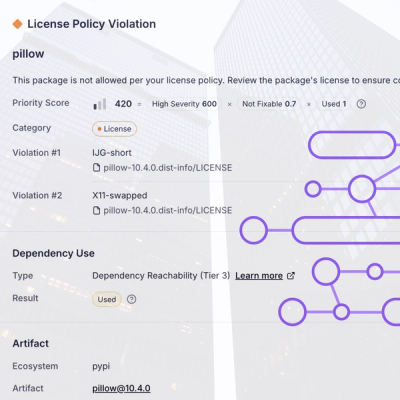
Research
/Security News
Critical Vulnerability in NestJS Devtools: Localhost RCE via Sandbox Escape
A flawed sandbox in @nestjs/devtools-integration lets attackers run code on your machine via CSRF, leading to full Remote Code Execution (RCE).
wsrepl - Websocket REPL for pentesterswsrepl is an interactive websocket REPL designed specifically for penetration testing. It provides an interface for observing incoming websocket messages and sending new ones, with an easy-to-use framework for automating this communication.

curl with wsrepl)You can download and install wsrepl using pip:
pip install wsrepl
Alternatively, you can clone this repository and install it from source:
git clone https://github.com/doyensec/wsrepl
cd wsrepl
pip install .
The basic command for starting wsrepl is as follows:
wsrepl -u URL
Replace URL with your target websocket URL, e.g. wss://echo.websocket.org. For more options and settings, you can use the -h or --help option:
usage: wsrepl [-h] [-u URL] [-i] [-s] [-k] [-X REQUEST] [-H HEADER]
[-b COOKIE] [--compressed] [-S] [-A USER_AGENT] [-O ORIGIN]
[-F HEADERS_FILE] [--no-native-ping]
[--ping-interval PING_INTERVAL] [--hide-ping-pong]
[--ping-0x1-interval PING_0X1_INTERVAL]
[--ping-0x1-payload PING_0X1_PAYLOAD]
[--pong-0x1-payload PONG_0X1_PAYLOAD] [--hide-0x1-ping-pong]
[-t TTL] [-p HTTP_PROXY] [-r RECONNECT_INTERVAL]
[-I INITIAL_MESSAGES] [-P PLUGIN] [-v VERBOSE]
[url_positional]
Websocket Client
positional arguments:
url_positional Websocket URL (e.g. wss://echo.websocket.org)
options:
-h, --help show this help message and exit
-u URL, --url URL Websocket URL (e.g. wss://echo.websocket.org)
-i, --include No effect, just for curl compatibility
-s, --silent No effect, just for curl compatibility
-k, --insecure Disable SSL verification
-X REQUEST, --request REQUEST
No effect, just for curl compatibility
-H HEADER, --header HEADER
Additional header (e.g. "X-Header: value"), can be
used multiple times
-b COOKIE, --cookie COOKIE
Cookie header (e.g. "name=value"), can be used
multiple times
--compressed No effect, just for curl compatibility
-S, --small Smaller UI
-A USER_AGENT, --user-agent USER_AGENT
User-Agent header
-O ORIGIN, --origin ORIGIN
Origin header
-F HEADERS_FILE, --headers-file HEADERS_FILE
Additional headers file (e.g. "headers.txt")
--no-native-ping Disable native ping/pong messages
--ping-interval PING_INTERVAL
Ping interval (seconds)
--hide-ping-pong Hide ping/pong messages
--ping-0x1-interval PING_0X1_INTERVAL
Fake ping (0x1 opcode) interval (seconds)
--ping-0x1-payload PING_0X1_PAYLOAD
Fake ping (0x1 opcode) payload
--pong-0x1-payload PONG_0X1_PAYLOAD
Fake pong (0x1 opcode) payload
--hide-0x1-ping-pong Hide fake ping/pong messages
-t TTL, --ttl TTL Heartbeet interval (seconds)
-p HTTP_PROXY, --http-proxy HTTP_PROXY
HTTP Proxy Address (e.g. 127.0.0.1:8080)
-r RECONNECT_INTERVAL, --reconnect-interval RECONNECT_INTERVAL
Reconnect interval (seconds, default: 2)
-I INITIAL_MESSAGES, --initial-messages INITIAL_MESSAGES
Send the messages from this file on connect
-P PLUGIN, --plugin PLUGIN
Plugin file to load
-v VERBOSE, --verbose VERBOSE
Verbosity level, 1-4 default: 3 (errors, warnings,
info), 4 adds debug
To automate your websocket communication, you can create a Python plugin by extending the Plugin class in wsrepl. This class allows you to define various hooks that are triggered during different stages of the websocket communication.
Here is an outline of how to define a plugin:
class MyPlugin(Plugin):
# Messages that will be sent to the server on (re-)connect.
messages = ["message1", "message2", "message3"]
def init(self):
# This method is called when the plugin is loaded.
# Use it to set initial settings or generate self.messages dynamically.
pass
async def on_connect(self):
# This method is called when the websocket connection is established.
pass
async def on_message_received(self, message: WSMessage):
# This method is called when a message is received from the server.
pass
# ... Other hooks can be defined here.
Refer to the source of Plugin class for the full list of hooks you can use and what they do:

Here is an example of a plugin that sends a predefined authentication message to a server:
from wsrepl import Plugin
import json
class AuthPlugin(Plugin):
def init(self):
auth_message = {
"messageType": "auth",
"auth": {
"user": "user-1234"",
"password": "password-1234"
}
}
self.messages = [json.dumps(auth_message)]
This plugin can be used by specifying it when running wsrepl:
wsrepl -u URL -P auth_plugin.py
Replace URL with your target websocket URL and auth_plugin.py with the path to the Python file containing your plugin.
docs/ directory contains a few more example plugins.
Contributions to wsrepl are welcome! Please, create an issue or submit a pull request if you have any ideas or suggestions. In particular, adding more plugin examples would be very helpful.
This project has been sponsored by Doyensec LLC.
FAQs
Websocket REPL for pentesters
We found that wsrepl demonstrated a healthy version release cadence and project activity because the last version was released less than a year ago. It has 1 open source maintainer collaborating on the project.
Did you know?

Socket for GitHub automatically highlights issues in each pull request and monitors the health of all your open source dependencies. Discover the contents of your packages and block harmful activity before you install or update your dependencies.

Research
/Security News
A flawed sandbox in @nestjs/devtools-integration lets attackers run code on your machine via CSRF, leading to full Remote Code Execution (RCE).

Product
Customize license detection with Socket’s new license overlays: gain control, reduce noise, and handle edge cases with precision.

Product
Socket now supports Rust and Cargo, offering package search for all users and experimental SBOM generation for enterprise projects.